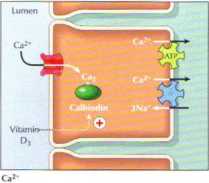47750 netter160

GASTROINTESTINAL PHYSIOLOGY
Absorption of Essential Elements and Vitamins


Iron

|
Element |
Site of Absorption |
Mcchanism |
|
Ca2* |
Duodenum and jejunurn |
Active |
|
Fe2* |
Duodenum and jejunum |
Facilitated diffusion |
|
Water-Soluble Vitamins | ||
|
Vitamin C |
lleum |
Na*-coupled/2° acłive |
|
Thiamin (Bj) |
lejunum |
Na*-C0upled/2° active |
|
Ribotlavin (B2) |
Jejunum |
Na~-coupled/2“ active |
|
Biotin |
Jejunum |
Na*-coupled/2° active |
|
Vitamin B12 |
lleum |
Facilitated diffusion |
|
Pyridoxine (Bb) |
Jejunum and ileum |
Passive diffusion |
|
Fat-Soluble Vitamins | ||
|
Vitamin A |
Jejunum and ileum |
Passive diffusion |
|
Vitamin D |
Jejunum and ileum |
Passive diffusion |
|
Vitamin E |
Jejunum and ileum |
Passive diffusion |
|
Vitamin K |
Jejunum and ileum |
Passive diffusion |

Fal-Soluble Vitamins J. Perkins
Figurę 7.38 Absorption of Essential Vitamins and Elements .
The celi mechanisms involved in the absorption of Ca", iron, and several imporiant vitamins are summarized. Vitamin D, (1,25-dihy-droxy-vitamin D,) plays an imporiant role in stimulating inteslinal Ca ‘ absorption. Intrinsic tactor is madę by the stornach (see Figuro 7.12). If insufficient amounts of intrinsic tactor are produced, B,.. deficiency ensues. Failure to property digest fats (see Figurę 7.37) can lead to deficiencies of the fat-solu-ble vitamins. Abbreviations: DMTI, Divalenl metal transporter 1: FR. tuirireductase; H. hephaestin; IF, intrinsic factoi: IREC1, iron-regulated transporter 1; TCII, transcobalamin II; TF, transferom
178
Wyszukiwarka
Podobne podstrony:
netter156 GASTROINTESTINAL PHYSIOLOGY Overvievv of Cii Trać! Fluid and Electrolyte Transport Ingest
netter132 GASTROINTESTINAL PHYSIOLOGY Appetite and Hunger Smell I Vcntomcdial hypothalami .offood 1
netter158 GASTROINTESTINAL PHYSIOLOGY Digestion of Carbohydrales Maftose Pancreatic amyiase
82393 netter97 RESPIRATORY PHYSIOLOGYRole of the Lungs in Acid-Base BaLar A. Role ot Lungs and Kidne
netter124 GASTROINTESTINAL PHYSIOLOGY Lowrr Esophageal Sphincter mm Mr Normal LES tonę is physiologi
netter140 GASTROINTESTINAL PHYSIOLOGY Smali Intestinc Structure: III Mitochondria Tight junctions ■
netter85 RESPIRATORY PHYSIOLOGYMechanits of Respiration: Airway Flo» Laminar flow occurs mainly in s
więcej podobnych podstron